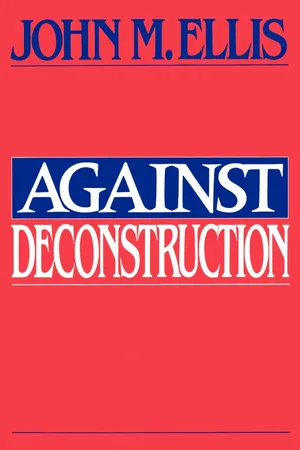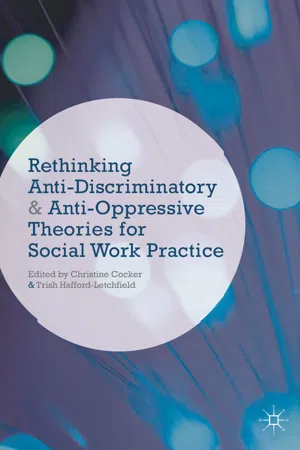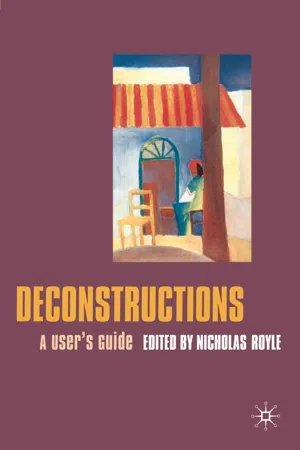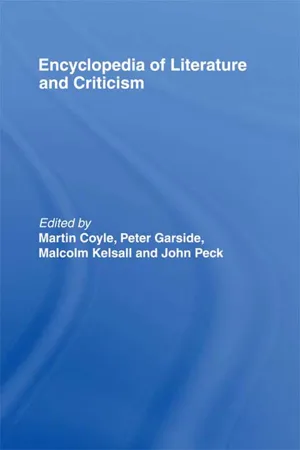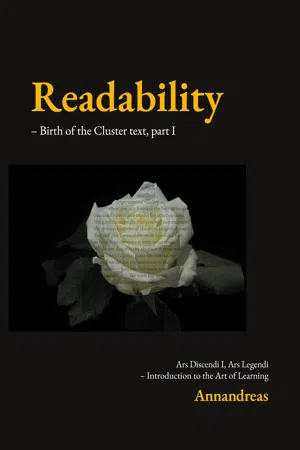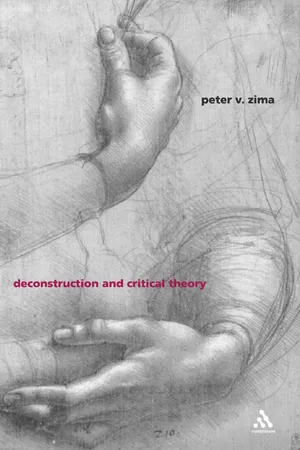Literature
Deconstruction
Deconstruction is a literary theory that seeks to uncover the underlying assumptions and contradictions within a text. It challenges traditional notions of meaning and binary oppositions, emphasizing the ambiguity and complexity of language. Deconstruction aims to reveal the inherent instability and multiple interpretations of a text, highlighting the fluidity of language and the impossibility of arriving at a fixed, singular meaning.
Written by Perlego with AI-assistance
Related key terms
1 of 5
12 Key excerpts on "Deconstruction"
- eBook - PDF
- John Martin Ellis(Author)
- 2018(Publication Date)
- Princeton University Press(Publisher)
Deconstruction does and must then require that the traditional idea be held still and allow itself to be deconstructed and retained; and the whole resulting complex is the result of the deconstructive method. Since Deconstruction wants to show that the text says the op- posite (or also says the opposite) of what it seems to say or is traditionally thought to say, the traditional version is the ref- erence point that Deconstruction needs both during and after it has done its work in order to exist. There is another way in which the deconstructive program for reading and interpreting literary texts is often stated in more defensible and plausible terms, again at the cost of sur- rendering its distinctive character and merging with any good criticism—that is, ceasing to be Deconstruction. On occasion, Deconstruction is defended as a mode of reading that pays at- tention not only to the surface but also to concealed subtleties beneath it, so producing an interpretation that does justice to the different levels at which a text operates. These different 7 i C H A P T E R T H R E E levels may even run counter to each other, so that there is a tension between them: to use the language of an exponent, there are then "warring forces of signification." 2 But anyone familiar with criticism over the last half century will quickly see that we are now very close to a generalized description of what good, alert criticism has been doing for a long time. In- deed, one of the standard procedures of the New Critics was to show how the obvious surface characteristics of a text (plot, major events, explicit themes) could be complicated by textual detail (imagery, metaphor, etc.) that ran counter to the text's more obvious surface content; the resulting tensions and in- congruities then required a more inclusive and complex inter- pretation embracing all levels. - eBook - ePub
On Deconstruction
Theory and Criticism after Structuralism
- Jonathan Culler(Author)
- 2014(Publication Date)
- Cornell University Press(Publisher)
Despite the manifest relevance to literary studies of the relation between reading and misreading, the implications of Deconstruction for the study of literature are far from clear. Derrida frequently writes about literary works but has not dealt directly with topics such as the task of literary criticism, the methods for analyzing literary language, or the nature of meaning in literature. The implications of Deconstruction for literary study must be inferred, but it is not clear how such inferences are to be made. The argument that all readings are misreadings, for example, does not seem to have logical consequences that would compel critics to proceed differently, yet it may well affect the way critics think about reading and the questions they pose about acts of interpretation. In this case as in others, that is to say, the Deconstruction of a hierarchical opposition does not entail or compel changes in literary criticism, yet it can have considerable impact on how critics proceed. In particular, through its questioning of the philosophical oppositions on which critical thought has inevitably relied, Deconstruction raises theoretical issues that critics must either ignore or pursue. By disrupting the hierarchical relations on which critical concepts and methods depend, it prevents concepts and methods from being taken for granted and treated as simply reliable instruments. Critical categories are not just tools to be employed in producing sound interpretations but problems to be explored through the interaction of text and concept. This is one reason why criticism seems so theoretical these days: critics more readily investigate how critical categories are affected by the works they are used to analyze.Before passing, in Chapter Three, to a discussion of the literary criticism indebted to Derridean Deconstruction, we should assess the consequences for literary theory and criticism of the deconstructive practice we have been expounding. One can distinguish four levels or modes of relevance. The first and most important is Deconstruction’s impact upon a series of critical concepts, including the concept of literature itself; but Deconstruction also has effects in three other ways: as a source of themes, as an example of reading strategies, and as a repository of suggestions about the nature and goals of critical inquiry. - Christine Cocker, Trish Hafford-Letchfield(Authors)
- 2014(Publication Date)
- Bloomsbury Academic(Publisher)
The emphasis is on the interplay between various elements in the production of meaning. The reader, as a culturally and historically specific individual, brings a framework of assumptions, values and interpretive strategies to bear on the text. Also, the text itself is not seen as a neutral or finished object: both its production and its reception take place in an actual, ‘real’ world, ‘a world that is culturally, socially and institutionally determined; that is messy, noisy, and full of disturbances, surprises, and instabilities’ (Birch, 1989, p. 2). Understanding a text thus becomes a matter of interpretation. This emphasis on the element of interpretation and, ultimately, of undecideability has provoked considerable critical challenge to the utility and morality of Deconstruction, and it is to these challenges that I now turn. Derrida’s approach to the text is designed to expose and destabilise assumptions embedded in language, but the strategies he adopts in order to carry out this ‘Deconstruction’ have been seen (and critiqued) as ranging from the wilfully obscure to the bizarre. Deconstructive reading of the kind demonstrated by Derrida is a challenge – both to undertake and, in some cases, to understand: Rather than attempting to defend his views using clear analytic arguments, he […] uses words in novel ways, makes puns, breaks up words in unusual places, exploits ambiguities and traces inventive etymologies that reveal connections between words that were not obvious before. (Prinz, 2009, p. 56) Furthermore, while the importance of context in the creation of meaning is widely accepted, the emphasis on interpretation, and recognition of undecideability, that Deconstruction introduces has been seen as problematic. If the text does not have a fixed meaning, it is argued, we soon find ourselves in a world governed by the logic of Humpty Dumpty (Carroll, 1872, p- eBook - ePub
- Vincent B. Leitch(Author)
- 2009(Publication Date)
- Routledge(Publisher)
20 Significantly, a commentary could neither exhaust a text nor employ a language safe from figural errancy—free from rhetoricity and allegory. There was no metalanguage, despite the scientific claims of structuralists and semioticians.Deconstructive critics championed immanent reading. Carefully tracing and repeating selected textual elements (figures, concepts, themes), the deconstructors unleashed the disruptive powers inherent in all repetition. Essentially, critical repetition set in motion the operations of difference , summoning up a disorienting chain of substitutions and displacements to destabilize textual systems. Miller demonstrated the critical force of such differential repetition in his book of readings of English novels, aptly titled Fiction and Repetition (1982).The Deconstruction of a text entailed the broad subversion of the logocentric tradition. “The so-called ‘Deconstruction of metaphysics,’” argued Miller, “has always been a part of metaphysics, a shadow within its light” (LM , 62). All texts contained both the traditional materials of metaphysics and the subversion of these materials. “This subversion is wrought into the conceptual words, the figures, and the myths of the Occident as the shadow in its light.”21 What this argued was that deconstructive reading involved immanent historical critique: there was no need and no possibility of stepping outside the age-old self-deconstructing logocentric system. Western literature, philosophy, and culture already contained the incompatibilities, duplicitous tropes, discontinuities, and undecidables essential to contemporary Deconstruction. History and tradition were encrypted or inscribed in a massive and labyrinthine prison house of texts, which were metaphysical and deconstructive at once.“A literary text is not a thing in itself, ‘organically unified,’ but a relation to other texts which are relations in their turn. The study of literature is therefore a study of intertextuality.”22 For deconstructors intertextuality designated a text’s dependence on and infiltration by prior concepts, figures, codes, unconscious practices, conventions, and texts. As a crucial critical instrument, intertextuality - eBook - ePub
Deconstructions
A User's Guide
- Nicholas Royle(Author)
- 2017(Publication Date)
- Bloomsbury Academic(Publisher)
rare, L19. 2. A strategy of critical analysis of (esp. philosophical and literary) language and texts which emphasizes features exposing unquestioned assumptions and inconsistencies. L20.Impossibly, I want to do justice to these different definitions. (There, in passing, is another definition, perhaps: Deconstruction is the attempt to come to terms with the fact that justice necessarily ‘exceeds law and calculation’, that it cannot be programmed but comes from the future, and that ‘one must always say perhaps for justice’: see Derrida, 1990a, p. 971.) If I say that the Chambers definition is less accurate, less responsible than the longer or shorter OED’s, this does not mean I find the OED definitions unproblematic. I want to spell out what is just plain wrong about your definition; but I also want to suggest that none of these definitions is finally perhaps very useful.As I was saying, on the subject of your definition of Deconstruction as ‘a method … applied esp to literary texts’: one of the most lucid and concise texts that Derrida has written on the subject of ‘what is Deconstruction?’ is ‘Letter to a Japanese Friend’. (A letter, like the one you are reading at the moment: I believe there is some significance in this fact of letter writing, I mean to do with the nature of Deconstruction. Letter writing is strangely lonely, alone but not alone. It is singular – just me writing, for example, to just you – but also general, in the sense that a letter must in principle be readable in our absence, even after our deaths. Finally, letter writing will have been an experience – the experience and experiment of a writing in which I do not readily know what I am going to say. In another epistolary text, called ‘Telepathy’, Derrida appropriately recalls Flaubert observing, in a letter to Louise, ‘Only just up, I am writing to you without knowing what I am going to say’ (Derrida, 1988b, p. 12). This also makes me think of Aspects of the Novel - eBook - ePub
British Post-Structuralism
Since 1968
- Antony Easthope(Author)
- 2019(Publication Date)
- Taylor & Francis(Publisher)
12Deconstruction…in truth the loss of what has never taken place, of a self-presence which has never been given but only dreamed of…Derrida, cited Oxford Literary ReviewThis present chapter concerns Deconstruction proper, that is, the American development from sources in Derrida of a particular set of protocols for reading texts. Since those texts are most often literary texts, this is really a second chapter on literary studies. The line of march is less clear, for reasons that will become apparent.Althusser and de Man on literature
We may begin by setting alongside each other two contrasting passages on literature and literary theory. The first, written in 1966, is from Althusser’s “A letter on art”:What art makes us see , and therefore gives to us in the form of ‘seeing’, ‘perceiving’ and ‘feeling’ (which is not the form of knowing) , is the ideology from which it is born, in which it bathes, from which it detaches itself as art, and to which it alludes. Macherey has shown this very clearly in the case of Tolstoy, by extending Lenin’s analyses. Balzac and Solzhenitsyn give us a ‘view’ of the ideology to which their work alludes and with which it is constantly fed, a view which presupposes a retreat , an internal distantiation from the very ideology from which their novels emerged. They make us ‘perceive’ (but not know) in some sense from the inside , by an internal distance , the very ideology in which they are held. (1977b, p.204)The second is longer and occurs in Paul de Man’s Blindness and insight , published in 1971. Referring back to the work of critics (Lukács, Poulet, Blanchot) it has discussed, it claims that their critical stance is defeated by their own critical results, and from this continues:A penetrating but difficult insight into the nature of literary language ensues. It seems, however, that this insight could only be gained because the critics were in the grip of this peculiar blindness; their language could grope toward a certain degree of insight only because their method remained oblivious to the perception of this insight. The insight exists only for a reader in the privileged position of being able to observe the blindness as a phenomenon in its own right — the question of his [sic] - eBook - ePub
- Martin Coyle, Peter Garside, Malcolm Kelsall, John Peck(Authors)
- 2002(Publication Date)
- Routledge(Publisher)
57 Deconstruction Nigel Mapp DOI: 10.4324/9780203403624-63In a typically thorny locution, Paul de Man notes approvingly of ‘Deconstruction’ that ‘no other word states so economically the impossibility to evaluate positively or negatively the inescapable evaluation it implies’ (1979, p. x). How might this be, since the word conjures the painful impression of pulling something apart? And does not Deconstruction leave texts looking very little as we are used to seeing them? A deconstructive reading does indeed have a target in view, but normally that target is the tradition of interpretation surrounding the work under scrutiny. And this attack is not (usually) stimulated by the desire for an exciting or original case. Deconstruction in fact springs from a respect for the text at hand, and for the terms of understanding that it lays down. It is by adhering to this principle that the deconstructive reading proves opposed to the critical tradition. Therefore, the upshot of Deconstruction is not a destroyed literary or philosophical work. Barbara Johnson argues the point thus:Deconstruction is not synonymous with destruction____It is in fact much closer to the original meaning of the word analysis, which etymologically means ‘to undo’—a virtual synonym for ‘to de-construct’. The de-construction of a text does not proceed by random doubt or arbitrary subversion, but by the careful teasing out of warring forces of signification within the text itself. If anything is destroyed in a deconstructive reading, it is not the text, but the claim to unequivocal domination of one mode of signifying over another.(1980, p. 5)It appears that reading has just been bad before now. But care is to be taken here. In this instance, ‘analysis’ proves misleading, as will any attempt to provide ‘a virtual synonym’ for ‘Deconstruction’. This is because ‘Deconstruction’ is also a name for what makes definition impossible. - eBook - PDF
- L. Ferretter(Author)
- 2002(Publication Date)
- Palgrave Macmillan(Publisher)
Let us be clear. I am not arguing, in the manner of Mark Taylor, that Deconstruction teaches Christian theology something new, to which it must thereafter conform. On the contrary, Deconstruction repeats for theology a fundamental caveat of which, in its depths, it has always been aware, namely that it exists in a double bind. On the one hand, it does and must use our language to speak of God. On the other hand, our language is as such inadequate to the task. As Ward says, this does not negate the meaning of theological statements. Derrida himself supports this view. In his reading of philosophical texts, a deconstructed text is not simply assigned to meaninglessness. The conclusion is not that the 16 Towards a Christian Literary Theory text is metaphysical and therefore not true. This approach Derrida describes as ‘turning the page of philosophy (which usually amounts to philosophising badly)’, by which he means that there is no question of a non-metaphysical language in which one could dismiss or falsify metaphysics. 54 Rather, what is necessary, for Derrida, is: to surround the critical concepts with a . . . discourse . . . to mark the conditions, the medium and the limits of their effectiveness . .. and, in the same process, designate the crevice through which the yet unnameable glimmer beyond the closure can be glimpsed. 55 This double task is, in a certain sense, that of theology. On the one hand it must use the worldly material of language to speak of God, since this is all that is available. On the other hand, and with precisely this language, it must also point out its incapacity to name God, who is wholly other than the world to which it applies. It is a question, as Derrida puts it elsewhere, of ‘conserving all [the] old concepts . - eBook - ePub
Readability (1/2)
Birth of the Cluster text, Introduction to the Art of Learning.
- - Annandreas(Author)
- 2021(Publication Date)
- Books on Demand(Publisher)
You assume a text and deconstruct it based on some assumption within it. Deconstruction assumed that the text could contradict itself. There is a gap between the intentions of the author and the meaning of the text that we can focus to find cracks. There may be a difference in what the author believes and argue in their writing and what the text »really« says. A text is beyond the author’s control when it reaches its audience. A writer cannot think of everything. Peter Kemp described it as if the text carries death, or more delicately, the absence of the author. 427 We can ask questions about what is hidden in a text, and it could cause us to find erroneous assumptions, or to introduce or change a difference, and in the next step to interpret the text itself based on the assumptions. In a successful Deconstruction, one can »damage« the metaphysical, epistemical, or rhetorical structures that a text takes for granted. You get a text that cracks based upon its own assumptions. You get another text that you can advise differently when you are looking for options of action. Above, I refer to the content of a text. I do something similar to the design of the text. I am performing a serious game with the binary single-space text/cluster text. I do this throughout this book with the binary word/space. It is possible to use much of the Deconstructionist discourse in the case of the cluster text. The cluster space can be seen as difference and supplement. We have not thought about it. We cannot hear the space, and in a phonocentrism, we do not consider what is not heard. The margins of the text change. I draw attention to the spaces and the margins, i.e. the marginal (marge), instead of the words that are usually considered central. I can say, with the own assumptions of Deconstruction, that the Deconstruction itself is both logocentric and phonocentric - eBook - ePub
Derrida
Deconstruction from Phenomenology to Ethics
- Christina Howells(Author)
- 2013(Publication Date)
- Polity(Publisher)
4 Deconstructing the Text: Literature and PhilosophyJust as Derrida considers traditional conceptions of the relationship between speech and writing to be false and misleading, so he considers the classical opposition between literature and philosophy to be based on an erroneous view of the nature of both. The opposition is predicated on the belief that literature is concerned with aesthetic representation, style and fiction, whereas philosophy is the domain of truth, objectively presented. This familiar binary opposition is one of the most significant targets of Derrida’s deconstructive analysis, in the first place because philosophy deludes itself and its adherents if it claims to present Truth, independent of the language used to express it. This has already been discussed in previous chapters with respect to fields such as geometry and phenomenology. And secondly because literature is not primarily fictional representation, clothed in a pleasing style: the last chapter demonstrated how much more complex Derrida’s conception of language is than this classical model. Derrida considers both literature and philosophy as ‘texts’, and the implications of this will become progressively clearer. It means that philosophical texts are subject to the same kind of analysis as literary ones; to some eyes this may look suspiciously like treating the philosophical text as if it were literature, but this suspicion is based on the assumption that philosophy is ‘above’ questions of its language, operating in an ideal domain of pure truth which Derrida is precisely questioning. We saw Habermas accuse Derrida of approaching philosophical texts via a critique of style, and Derrida’s curt retort: ‘Cela est faux’ (Limited Inc. , 245). It is false because the very term ‘style’ is part of the style/content opposition which Derrida contests. But it is none the less true that Derrida approaches texts traditionally viewed as ‘philosophical’ with the same deconstructive protocol as he approaches those traditionally viewed as ‘literary’, and in this sense what he has to say about literature is also pertinent to philosophy. What is certain, however, is that Derrida rejects any assimilation of philosophy to literature, as he has been forced to stress repeatedly over recent years in the face of an uncomprehending backlash from certain philosophical quarters, explaining that deconstructing and questioning an established distinction is not the same as denying its existence. The complexity of the relationship between philosophy and literature, the history, conventions and limits of the two types of text, indeed, the ‘turbulence’ of their relationship, are among the questions that are explored most forcefully in his own writings. (See the interview entitled ‘Y a-t-il une langue philosophique?’, 1988, in Points de suspension - eBook - PDF
Aestheticism and Deconstruction
Pater, Derrida, and de Man
- Jonathan Loesberg(Author)
- 2014(Publication Date)
- Princeton University Press(Publisher)
2 1n effect, Pater's heirs and Deconstruction's critics share a proposition that it has been the aim of this book to refute: forms of representation, most Significantly literature and language, have an ir- revocable inside to which there is an inescapable outside given various names, history, political activity, ideological hegemony, empirical or transcendental truth. This being the case, any position to the effect that literary language or aesthetic experience is constitutive and com- prehensive must deny the reality of those alternatives. Derrida's and de Man's skeptical discussions of philosophic and literary theories of meaning may easily be construed as an espousal of language as a structure opposed to all external referents. But Pater never questioned meaning. He based his philosophy and aesthetics on a grounding in experience, however paradoxically he defined that experience. Yet his followers construed him to argue the alterity of artistic intensity, the desirability for an enclosure within art. Thus the problem is not the specific arguments Deconstruction espouses but the attack it shares with Pater's aestheticism upon this foundational belief that the aes- thetic always excludes an outside, that one must either break out of it into the real, or establish a sanctuary within it. Without a preliminary belief that art and language stand in opposi- tion to direct discourse and represented reality, a contention that our understanding of history, for instance, follows certain literary or lin- guistic structures could not lOgically produce the corollary that there is nothing but language. Rather, one would think that the consequence of DBCONSTRUCTIVE AESTHETICS 123 that statement would be that historic comprehension, and extrication from the ideologies that obstruct that comprehension, would follow from a fully articulated understanding of the ways literary and lin- guistic structures have made history by making our understanding of it. - eBook - PDF
- Peter V. Zima(Author)
- 2002(Publication Date)
- Continuum(Publisher)
He is of course right when he points out in his study on Derrida that C R I T I Q U E O F D E C O N S T R U C T I O N 1 7 7 Deconstruction is a call to think ‘through the paradoxes in the nature of reason’. 26 Fortunately or unfortunately, Deconstruction is a lot more, since Derrida, de Man and Hartman frequently sacrifice formal (propositional) logic in favour of a rhetoric of subjective association (see Chapter 2, section 5) and an essayism located beyond right and wrong. If the Deconstructionists had remained content to reflect on the paradoxes of reason, their problems would be comparable to those of Wittgenstein or analytic philosophy. The impossibility of aligning Deconstruction with analytic thinking is mainly due to its dialectical origin. This dialectical origin is also neglected by Samuel C. Wheeler in his otherwise stimulating study on Deconstruction as Analytic Philosophy. According to Wheeler, both Derrida and Donald Davidson reject the metaphysical idea of language: the idea that meaning is spontaneously present in language which is a non-problematical manifestation of the Platonic nous. ‘The fundamental point of agreement between Derrida and Davidson, as well as other thinkers in the analytic tradition such as Quine and Wittgenstein’, Wheeler explains, ‘is their denial of what I call the “magic language”. This is the language of nous , a language that is, in Wittgenstein’s terms, self-interpreting.’ 27 One might also say that some thinkers in the linguistic (rather than analytic) tradition reject the idea of an objectively given meaning in language which to them appears as a permanent interaction between the content plane , the expression plane and an always open context of communication. It is one of their basic aims to analyse this interaction with utmost precision – and one might say in defence of Derrida that he is no less precise than the analytic philosophers.
Index pages curate the most relevant extracts from our library of academic textbooks. They’ve been created using an in-house natural language model (NLM), each adding context and meaning to key research topics.
